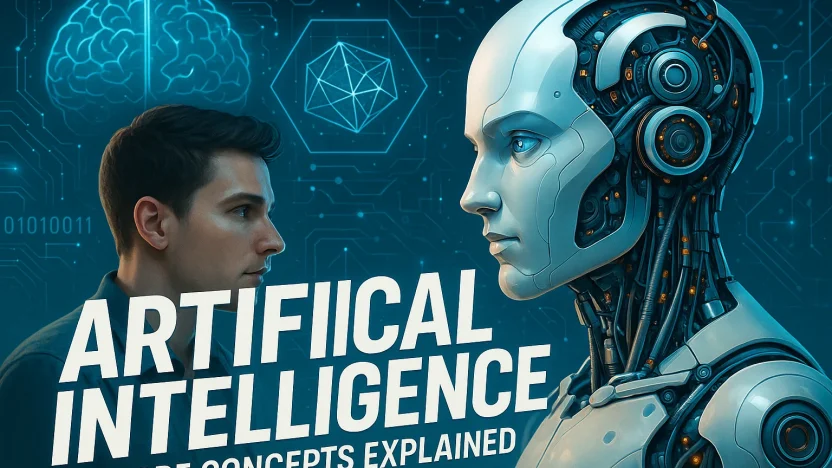AI has gone from being a theoretical idea to a key part of modern technology that affects both businesses and everyday life. But how did we get to this point? What are the main ideas that make this field so interesting? In this in-depth look, we’ll cover the basics of AI, its history, important ideas, methods, and effects. Then we’ll go even further with real-world examples, evaluation metrics, MLOps, governance, and what all of this means for builders, leaders, and curious readers in 2026 and beyond.

Are you ready to uncover the bedrock of AI?
So, let’s get started.
SUMMARY: Artificial intelligence is more than just a buzzword; it’s a transformative force that’s changing how we interact with the world. To truly appreciate the nuances of AI, it’s essential to understand its foundations. This article walks through the history of AI, the core principles that drive it, and the methodologies that brought us to today’s state of the art. We’ll also expand on practical building blocks—like datasets, model evaluation, and MLOps—plus the ethical, legal, and societal considerations that every responsible AI team should weigh.
AI History: A Timeline of Major Milestones
The journey of AI began long before the term was coined. Here’s a detailed timeline of key developments:
| ???? Year | ????️ Event | ???? Description |
|---|---|---|
| 1950 | Alan Turing publishes “Computing Machinery and Intelligence.” | It presents the idea that a machine can demonstrate intelligence comparable to, or indistinguishable from, human behavior. This is where the famous Turing Test originated. Source |
| 1956 | Dartmouth Conference | John McCarthy coined the term “artificial intelligence.” People often cite this conference as the birth of AI as a field of study. Source |
| 1966 | Eliza was created by Joseph Weizenbaum. | An early natural language processing program demonstrated simple conversational abilities. Source |
| 1973 | AI Winter Begins | Limited computational power and unrealistic expectations led to a period of reduced activity in AI research funding. Source |
| 1997 | IBM’s Deep Blue defeats Garry Kasparov | A landmark moment occurred when a computer defeated a world-champion chess player, showcasing AI’s potential. Source |
| 2012 | The deep learning revolution begins. | AlexNet wins the ImageNet competition, sparking a new wave of interest in neural networks and deep learning. Source |
| 2023 | GPT-4 was released by OpenAI. | Advances in natural language processing reach new heights, enabling more sophisticated AI models capable of generating human-like text. Source |
Those milestones trace the arc from theory to practical impact. But the story didn’t stop there. Since 2023, the landscape has seen massive scaling of multimodal models (text, image, audio, and video in one system), on-device/edge AI for privacy and latency, and sharp growth in AI-assisted tooling across programming, design, marketing, research, and beyond. The core ideas remain—learn patterns, represent knowledge, and search for good solutions—but the scale, data diversity, and deployment environments have exploded.
AI’s Core Concepts

1. Machine Learning (ML)
Machine learning is a subset of AI that focuses on developing algorithms that allow computers to learn from and make data-driven decisions. There are three main types of ML.
| ???? Type | ???? Description | ???? Example |
|---|---|---|
| Supervised Learning | Each training example pairs with an output label, allowing algorithms to learn from labeled data. | Image classification and spam detection |
| Unsupervised Learning | Algorithms learn from unlabeled data, identifying patterns or groupings without specific output labels. | Clustering and dimensionality reduction |
| Reinforcement Learning | Agents learn by interacting with an environment and receiving feedback in the form of rewards or penalties. | Game playing, robotics control |
Supervised learning is the most commonly used type of ML. It’s particularly effective when historical data with clear labels is available—predicting housing prices, diagnosing images, or classifying messages. Unsupervised learning uncovers hidden structure (clusters, latent factors) and surfaces insights for segmentation, content organization, or anomaly detection. Reinforcement learning trains agents to make sequences of decisions (think autonomous navigation or resource allocation) by maximizing long-term rewards, sometimes augmented with human feedback (RLHF) for aligning behavior with human preferences.
2. Neural Networks and Deep Learning
Neural networks, which are based on how the human brain works, are the main part of many AI systems. A neural network is made up of layers of nodes (neurons). Each node receives input, processes it, and then sends the output to the next node.
Deep learning is when we add more layers and parameters to networks so they can find more subtle, higher-order patterns in data. Neural networks, inspired by the human brain’s structure, form the backbone of many AI systems.
A neural network consists of layers of nodes (neurons), where each node receives input, processes it, and passes the output forward. As we increase the number of layers and parameters, networks can capture subtler, higher-order patterns in data—this is deep learning.
Deep architectures learn representations on their own. The lower layers identify edges or tokens, the middle layers find shapes or phrases, and the top layers find objects, intent, or concepts. One reason deep learning has been so successful is that it has moved from handcrafted features to learned representations.
| ???? Concept | ???? Description | ???? Key Feature |
|---|---|---|
| Perceptron | The simplest form of a neural network has only one layer of neurons. | Single-layer network |
| Multi-Layer Perceptron (MLP) | A neural network with multiple layers of neurons allows for more complex computations. | Multiple layers, non-linear activation functions |
| Convolutional Neural Networks (CNNs) | There are specialized neural networks for processing grid-like data, such as images. | Convolutional layers, pooling layers |
| Recurrent Neural Networks (RNNs) | The design of neural networks allows them to handle sequential data, such as time series or natural language. | Memory cells and recurrent connections |
Deep learning has revolutionized computer vision and language. CNNs dominate image tasks; RNNs paved the way for sequence modeling; and transformers (self-attention-based architectures) now power most state-of-the-art models across text, image, audio, and multi-modal tasks. These models scale particularly well: more parameters + more data + more compute often leads to better generalization (with careful regularization and evaluation).
3. Natural Language Processing (NLP)
NLP is AI’s interface to human language—understanding, generating, translating, and reasoning with text and speech.
| ????️ Task | ???? Description | ????️ Example Application |
|---|---|---|
| Text Classification | We assign text categories, such as spam detection or sentiment analysis. | Email filtering, social media monitoring |
| Machine Translation | The system is capable of automatically translating text from one language to another. | Google Translate |
| Speech Recognition | Converting spoken language into text. | Virtual assistants (e.g., Siri, Alexa) |
| Named Entity Recognition (NER) | We identify entities in text, including names of people, organizations, or locations. | News articles contain information extraction. |
Modern NLP leans heavily on transformers that process sequences with attention, capturing long-range dependencies better than traditional RNNs. Large language models (LLMs) pretrain on vast corpora and then adapt via fine-tuning or prompting to specific tasks. This foundation model era has shifted the developer experience from building many small task-specific models to steering a small number of general models toward diverse tasks.
4. Search and Optimization
Search algorithms are fundamental to AI, enabling systems to explore possible solutions and find the most optimal outcome. They appear in games, planning, logistics, and even inside the training of models (hyperparameter search).
| ???? Algorithm | ???? Description | ???? Application |
|---|---|---|
| Breadth-first search (BFS) | The system investigates all possible nodes at the current depth before moving on to nodes at the next level. | Shortest path problems in graphs |
| Depth-First Search (DFS) | Explores as far down a branch as possible before backtracking. | Solving puzzles, navigating mazes |
| Genetic Algorithms | Mimics the process of natural selection to find approximate solutions to optimization problems. | Optimization problems and machine learning hyperparameter tuning are addressed. |
| A Algorithm* | The system combines BFS with a heuristic to efficiently find the shortest path. | Game pathfinding and route planning |
Search fuels planning (think robots moving through space), reasoning (proof search), and everyday products (maps routing). In learning systems, optimization (like stochastic gradient descent) drives parameter updates, while higher-level search tunes architectures and hyperparameters. These layers of search and optimization are the “invisible gears” of modern AI.
5. Knowledge Representation and Reasoning (KR&R)
KR&R is about how machines store facts, rules, and relationships—and reason with them. Even in the deep learning age, symbolic structures remain valuable for grounding, interpretability, and compliance.
| ???? Concept | ???? Description | ????️ Application |
|---|---|---|
| Ontologies | These are structured frameworks for organizing information, often in the form of a hierarchy or network of concepts. | Semantic web, data integration |
| Logic-Based Systems | The system uses formal logic to represent knowledge and reason about it. | Automated theorem-proving, expert systems |
| Bayesian Networks | Probabilistic models represent a set of variables and their conditional dependencies. | Risk assessment and decision support systems |
| Expert Systems | AI systems mimic the decision-making skills of a human specialist in a particular field. | Financial planning and medical diagnosis |
Neuro-symbolic AI blends neural pattern recognition with symbolic structure for reasoning, compliance, and grounding. This hybrid approach is useful when you need both pattern mastery (e.g., perception, language) and strict rule following (e.g., policy checks, safety constraints).
Methodologies in AI Development
AI development involves multiple paradigms that often work best in combination. Below are the major families and where they shine.
1. Symbolic AI
Symbolic AI—“good old-fashioned AI” (GOFAI)—encodes explicit knowledge with rules, logic, and graphs. It’s transparent and controllable, but brittle if the world doesn’t match the rules.
| ???? Methodology | ???? Description | ???? Example Application |
|---|---|---|
| Rule-Based Systems | The system uses if-then rules to derive conclusions or take actions based on known information. | Expert systems and decision-support systems |
| Logic Programming | The programming paradigm is based on formal logic. | Prolog, knowledge-based systems |
| Semantic Networks | We use graph structures to represent knowledge through patterns of interconnected nodes. | Natural language processing, information retrieval |
Symbolic systems are still invaluable for domains requiring auditability, certification, and explicit policy—think finance, healthcare, and compliance-heavy industries. They pair well with deep models by serving as guardrails or post-processing validators.
2. Statistical AI
Statistical AI grounds decisions in probability, uncertainty, and inference. When data is noisy and outcomes are uncertain, statistical models help quantify confidence and trade-offs.
| ???? Methodology | ???? Description | ???? Example Application |
|---|---|---|
| Bayesian Inference | Update beliefs with evidence using Bayes’ rule; quantify uncertainty in predictions and parameters. | Spam filtering and risk assessment |
| Markov Decision Processes (MDP) | Model sequential decisions where outcomes are partly random and partly under control. | Automated planning and robotics |
| Hidden Markov Models (HMMs) | Model sequences with hidden states driving observed emissions. | Bioinformatics, speech recognition |
These methods remain critical for explainability and decision support. Even in the age of giant neural networks, probabilistic approaches add robustness and clarity about what the model knows (and doesn’t).
3. Data-Driven AI
Data-driven AI—especially deep learning—optimizes parameters from examples rather than handcrafting rules. With enough high-quality data (and careful evaluation), these models excel at perception, language, and pattern-heavy tasks.
| ???? Methodology | ???? Description | ???? Example Application |
|---|---|---|
| Supervised Learning | We train algorithms on labeled data to predict outcomes for new data. | Image classification and fraud detection |
| Unsupervised Learning | Algorithms find patterns in unlabeled data. | Market segmentation and anomaly detection |
| Deep Learning | The system uses neural networks with many layers to model complex patterns in large datasets. | Autonomous vehicles and natural language processing |
Today’s frontier is multimodal learning—models that jointly learn from text, images, audio, video, and sensor streams, enabling richer reasoning and more intuitive interfaces (e.g., describing images, answering questions about charts, or following constraints in design tools).
The Math That Makes It Work (Without the Headache)
You don’t need a PhD to appreciate the math story. At a high level:
- Linear algebra moves data through layers: vectors, matrices, and tensors (for batched computations).
- Calculus powers gradient-based learning—how much to adjust each weight to reduce error.
- Probability & statistics quantify uncertainty, regularize models, and set expectations for performance variance.
- Optimization (SGD, Adam, Adagrad) provides the practical steps to actually train large models at scale.
These building blocks let us define a loss (what “wrong” looks like), measure it on data, and iteratively improve the model until it generalizes well. The art is in problem framing, data curation, and evaluation—because a perfectly trained model on the wrong objective or biased dataset can still produce harmful or useless results.
From Notebook to Production: MLOps Essentials
Most AI failures aren’t about models—they’re about operations. MLOps brings DevOps discipline to ML systems, ensuring models stay accurate, efficient, and compliant in the wild.
| Stage | What Matters | Tips |
|---|---|---|
| Data Pipeline | Quality, lineage, privacy | Automate checks for drift, PII scanning, schema tests |
| Experimentation | Reproducibility, tracking | Use experiment trackers; log code, data hashes, seeds |
| Training | Scalability, cost, fairness | Use spot instances; early stopping; bias audits |
| Evaluation | Robust, task-appropriate metrics | Beyond accuracy: calibration, subgroup metrics |
| Deployment | Latency, availability, safety | Canary releases, circuit breakers, guardrails |
| Monitoring | Drift, performance, incidents | Alert on metric shifts; human-in-the-loop review |
Model monitoring is crucial post-launch: data drifts, user behavior changes, and adversarial inputs appear. Build dashboards that track both technical metrics (latency, error rates) and business outcomes (conversion, retention), plus fairness and toxicity monitors where relevant.
How We Judge Models: Metrics That Matter
Accuracy is rarely enough. Choose metrics that reflect your real objective—especially for imbalanced data or high-stakes tasks.
| Task | Primary Metrics | Why They Matter |
|---|---|---|
| Classification | Precision, Recall, F1, ROC-AUC, PR-AUC | Balance between false positives/negatives; robust to imbalance |
| Regression | MAE, RMSE, R², Calibration | Magnitude of errors and how predictions track true values |
| Ranking/Search | MRR, NDCG, CTR | Order quality and user engagement |
| Generative (Text/Image) | Human evals, BLEU/ROUGE (text), CLIPScore/FID (image) | Quality is subjective; combine automated + human |
| Safety/Fairness | Bias indices, subgroup metrics, toxicity rates | Prevent harm; ensure equitable performance |
For LLMs and multimodal models, adopt red-teaming (structured adversarial testing) and eval suites combining automated probes with expert human reviews. Document limitations and safe-use guidelines—your future self (and users) will thank you.
Ethical Considerations in AI
As AI becomes more widespread, people are scrutinizing the ethical implications of its use more and more. Below is a list of some of the major ethical concerns associated with AI, plus practical steps for mitigation.
1. Bias in AI Systems
AI systems can inadvertently perpetuate or even amplify biases present in their training data. This can result in unfair outcomes in hiring, lending, healthcare, or criminal justice.
| ⚖️ Concern | ???? Description | ???? Impact |
|---|---|---|
| Algorithmic Bias | Biases in the training data lead to biased outcomes in AI models. | Discrimination in hiring and judicial decisions |
| Data Privacy | Large amounts of data are frequently required by AI systems, which raises questions about how to collect, store, and use this data. | Privacy breaches and unauthorized data usage |
| Transparency | The decision-making process of AI systems is often opaque, leading to concerns about accountability. | There is a lack of accountability and difficulty in challenging AI decisions. |
Mitigations: curate diverse datasets; run subgroup performance analyses; add bias detection gates to CI/CD; use techniques like counterfactual fairness checks; and ensure humans can override or appeal model decisions in sensitive workflows.
2. Autonomous Systems and Accountability
As autonomy increases (vehicles, drones, clinical decision support), we must define responsibility and escalation paths when things go wrong.
| ????️ Challenge | ???? Description | ???? Impact |
|---|---|---|
| Autonomy and decision-making | AI systems making decisions without human intervention can lead to unforeseen consequences. | Accidents involving autonomous vehicles and errors in medical diagnosis are common. |
| Liability | Determining who is liable when an autonomous system causes harm is a complex issue. | Legal challenges, regulatory uncertainty |
Mitigations: define human-in-the-loop or human-on-the-loop roles for critical decisions; maintain audit trails; document model provenance; and align with sector regulations and emerging AI governance standards.
3. The Future of Work
AI will automate some tasks, augment others, and create entirely new roles. Managing that transition thoughtfully is a leadership imperative.
| ???? Concern | ???? Description | ???? Impact |
|---|---|---|
| Job Displacement | Automation of tasks previously performed by humans can lead to job losses in certain industries. | Economic disruption and social inequality |
| Reskilling and education | As AI alters the nature of work, there is a growing demand for reskilling workers to equip them with the skills needed in the AI-driven economy. | Lifelong learning and workforce development |
Actions: invest in upskilling; adopt “AI + human” workflows that emphasize judgment and creativity; measure productivity and employee well-being; and ensure transparent communication about where and why AI is used.
Regulation & Governance: What Teams Should Know
In 2026, most AI builders operate under a patchwork of data protection laws (e.g., GDPR), sector regulations (health/finance), and emerging AI-specific frameworks. Consistent themes include:
- Risk-based approaches: stricter controls for high-risk uses (e.g., safety-critical or rights-impacting systems).
- Transparency: documentation of data sources, intended use, and limitations; disclosures when users interact with AI.
- Data minimization: collect only what’s necessary; protect PII; support data subject rights where applicable.
- Human oversight: defined escalation paths and intervention mechanisms.
Practical tip: maintain a model card (purpose, training data overview, metrics—including subgroup breakdowns—limitations, and safe-use guidance) and a system card (how the model is deployed, guardrails, and monitoring). This isn’t just compliance—it’s good engineering hygiene.
AI in the Real World: Industry Snapshots
| Industry | High-Impact Use Cases | Notes |
|---|---|---|
| Healthcare | Imaging triage, clinical documentation, personalized medicine | Human oversight essential; bias and safety critical |
| Finance | Fraud detection, credit risk, customer intelligence | Explainability and fairness constraints |
| Retail & CPG | Demand forecasting, recommendation, merchandising | Edge analytics for stores; privacy-aware personalization |
| Manufacturing | Predictive maintenance, quality inspection, robotics | Sensor fusion; closed-loop optimization |
| Media & Marketing | Content generation, creative ideation, audience modeling | Brand safety policies and human review |
| Public Sector | Citizen services, document processing, infrastructure planning | Transparency and accountability mandates |
Edge & On-Device AI
To reduce latency, protect privacy, and cut costs, more AI is running at the edge—on phones, cameras, vehicles, and IoT devices. Techniques like quantization, pruning, and distillation shrink models without gutting performance. The result: instant experiences (e.g., translation or vision on-device) and reduced dependence on cloud calls for every inference.
Prompting, Fine-Tuning, and RAG: How to “Steer” Foundation Models
- Prompt Engineering: Write instructions and examples that guide outputs; add structure (roles, constraints) to improve reliability.
- Retrieval-Augmented Generation (RAG): Ground models in your private knowledge base by retrieving relevant passages before generation—boosts accuracy and freshness.
- Fine-Tuning: Adapt the base model to your domain with curated, high-quality examples; use LoRA/PEFT for efficient training.
In practice, many teams start with prompting, layer on RAG for truthfulness, and then fine-tune where consistency or style control is paramount (e.g., support copilots, legal document drafting, structured code generation).
Security: Defending Models and Data
AI systems face unique attack surfaces: prompt injection, data poisoning, model theft, and adversarial examples. Treat your models as first-class assets in your security program.
- Input Hardening: sanitize prompts; constrain tool use; use allowlists/denylists.
- Output Filtering: add post-generation checks (toxicity, PII leakage, policy violations).
- Training Hygiene: provenance tracking; filter and dedupe; defend against poisoning.
- Access Controls: rate limits; API keys; audit logs; separate duties for sensitive actions.
Future Directions in AI
The pace isn’t slowing. A few vectors to watch:
1. Explainable AI (XAI)
As AI systems become more complex, there’s a growing need for models that can justify outputs. XAI includes post-hoc explanations (feature attribution, counterfactuals) and inherently interpretable models. In high-stakes settings, expect explanation requirements to become more formalized.
| ???? Trend | ???? Description | ???? Impact |
|---|---|---|
| Interpretability | They are creating models that can clarify their choices in a manner that is comprehensible to humans. | Increased trust in AI, better accountability |
| Transparency | We are ensuring that AI systems are transparent in their operations and decision-making processes. | Improved regulation and ethical AI development |
XAI is particularly important in healthcare and finance, where AI system decisions can have significant consequences. Clinicians and regulators alike expect traceability and human-readable rationale.
2. AI and Quantum Computing
Quantum computing could accelerate training and optimization for specific problem classes. While practical, general quantum advantages are still evolving; research in variational quantum circuits and quantum-inspired algorithms keeps this an exciting frontier.
| ???? Trend | ???? Description | ???? Impact |
|---|---|---|
| Quantum machine learning | We are combining quantum computing with machine learning to solve complex problems more efficiently. | There have been breakthroughs in AI and new applications in fields like cryptography and materials science. |
| Quantum Neural Networks | Developing neural networks that run on quantum computers will enable faster and more powerful AI models. | Enhanced AI capabilities, faster training times |
Expect early commercial traction in specialized optimization, simulation, and cryptography—not general-purpose AI—then gradual expansion as hardware and error correction improve.
3. AI in Personalized Medicine
AI is enabling precision medicine by connecting clinical data, imaging, genomics, and real-world evidence. The promise: earlier detection, better triage, and treatments tailored to individual biology and context.
| ???? Trend | ???? Description | ???? Impact |
|---|---|---|
| Precision Medicine | We are using AI to analyze large datasets of patient information to develop personalized treatment plans. | Improved patient outcomes, more effective treatments |
| Genomic data analysis | We are using AI to analyze genomic data to identify genetic markers for diseases and develop targeted therapies. | Early detection of diseases and personalized treatment options are critical. |
Challenges remain around data interoperability, bias, consent, and oversight—but the trajectory points to increasingly AI-augmented care teams rather than fully automated medicine.
Practical Guide: Building an AI Feature the Right Way
- Define the outcome: What user problem are you solving? How will you measure success (e.g., time saved, accuracy, revenue)?
- Scope the data: Identify sources, set quality bars, address privacy and consent, and decide on real-time vs. batch.
- Select an approach: Rule-based baseline? Small supervised model? RAG over your docs? Fine-tuned foundation model?
- Prototype: Build a thin slice. Get qualitative feedback early from real users.
- Evaluate: Use the right metrics; include subgroup and safety checks; document limitations.
- Deploy safely: Start with a pilot or canary; add guardrails; provide a clear “undo” and human escalation.
- Monitor and iterate: Track drift, performance, and user satisfaction. Close the loop with labeled feedback to improve.
Common Pitfalls (So You Can Avoid Them)
- Training on convenience data instead of representative data—leading to poor generalization.
- Overfitting to benchmarks while missing real-world constraints (latency, cost, UX).
- Ignoring governance until late—retrofits are painful; bake it in from day one.
- Shipping a model without a process—no monitoring, no feedback loop, no owner.
- Assuming “AI = magic”—good product thinking and change management still matter.
Glossary: Quick Definitions You’ll Actually Use
- Foundation Model: A large, pre-trained model adaptable to many tasks (e.g., LLMs).
- RAG: Retrieval-Augmented Generation—combine search over your data with model generation.
- LoRA/PEFT: Parameter-efficient fine-tuning methods that adapt large models cheaply.
- Prompt Injection: Malicious input that tries to hijack model behavior.
- Drift: When data or user behavior changes, causing performance to degrade.
- Calibration: How well predicted probabilities match actual outcomes.
Conclusion
Artificial intelligence (AI) is a multifaceted field with a rich history and a fast-evolving present. From early symbolic systems to deep learning and multimodal foundation models, the core mission hasn’t changed: represent knowledge, learn patterns, and make better decisions. What have changed are the tools, the scale, and the stakes.
Understanding the core concepts—learning paradigms, neural architectures, search, and reasoning—gives you the vocabulary to build or assess AI systems. Expanding into practice with MLOps, evaluation, security, and governance turns ideas into durable, responsible products. And keeping an eye on the horizon—XAI, edge AI, quantum, and AI-augmented industries—helps you make decisions that won’t age out next quarter.
The AI journey is far from over. But if you focus on the fundamentals, design for safety, and measure what matters, you’re already ahead of the curve—and well-positioned to create AI that’s not just powerful but useful and trustworthy in the world we actually live in.





[…] source http://www.toptut.com/foundations-of-artificial-intelligence/ […]